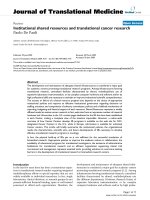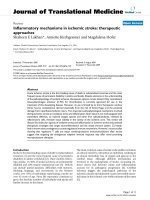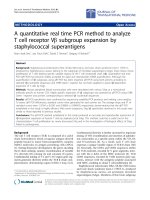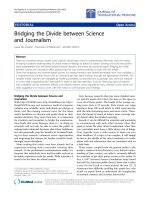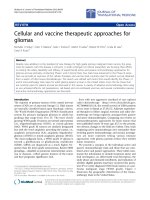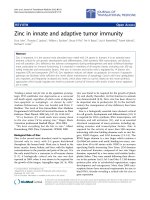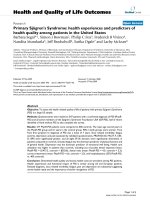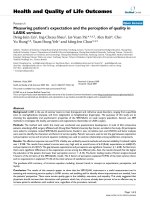báo cáo hóa học: " Understanding Ferguson''''s δ: time to say good-bye?" pot
Bạn đang xem bản rút gọn của tài liệu. Xem và tải ngay bản đầy đủ của tài liệu tại đây (430.88 KB, 7 trang )
BioMed Central
Page 1 of 7
(page number not for citation purposes)
Health and Quality of Life Outcomes
Open Access
Letter to the Editor
Understanding Ferguson's
δ
: time to say good-bye?
Berend Terluin*
1
, Dirk L Knol
2
, Caroline B Terwee
2
and Henrica CW de Vet
2
Address:
1
Department of General Practice and the EMGO Institute for Health and Care Research, VU University Medical Centre, Amsterdam, the
Netherlands and
2
Department of Clinical Epidemiology and Biostatistics, and the EMGO Institute for Health and Care Research, VU University
Medical Centre, Amsterdam, the Netherlands
Email: Berend Terluin* - ; Dirk L Knol - ; Caroline B Terwee - ; Henrica CW de
Vet -
* Corresponding author
Abstract
A critique of Hankins, M: 'How discriminating are discriminative instruments?' Health and Quality of
Life Outcomes 2008, 6:36.
Background
Recently Hankins (re-)introduced Ferguson's coefficient
δ
as an index of discrimination, to be distinguished from
the well-known measurement properties validity and reli-
ability [1,2]. Hankins presented Ferguson's
δ
as a useful
index of the degree to which an instrument discriminates
between individuals, being "the ratio of the observed
number of between-person differences to the theoretical
maximum number possible" [1]. The value of
δ
varies
between 0 (no discrimination at all) and 1 (maximal pos-
sible discrimination). The calculation is straightforward
and Hankins provided a generalized formula for calculat-
ing
δ
for questionnaires with dichotomous as well as pol-
ytomous items.
Hankins' paper [1] elicited two critical comments [3,4].
Wyrwich referred to the work of Guyatt [5] who related
discrimination tot reliability, theoretically consistent cor-
relations with other measures, and interpretability of
small but important differences. Since Hankins failed to
present relevant information regarding these issues, Wyr-
wich concluded that it is impossible to make a judgement
on whether Ferguson's
δ
is a useful index or not [3].
Whereas Hankins stated that discrimination is something
else than reliability, Norman expressed the opposite view,
i.e. that "reliability is discrimination". Scrutinizing Hank-
ins' examples and adding one of his own, Norman illus-
trated his main point that Ferguson's
δ
fails to distinguish
between true differences and measurement error [4]. In
his response, Hankins remarked that both Norman and
Wyrwich made too much of his examples, and seemed to
have missed his point, which is that Ferguson's
δ
is an
additional index of an instruments' measurement proper-
ties, beside reliability, validity and interpretability, and
that Ferguson's
δ
can only be computed on the assump-
tion that the measurement is valid and reliable [6].
In this letter, we will examine how exactly Ferguson's
δ
'works' and what
δ
actually measures. More specifically,
we will show that the magnitude of
δ
is only determined
by the distribution of the scores in a given sample. More-
over, we will show that the standard computation of
δ
ignores reliability, but, when reliability is accounted for,
δ
becomes impossible to interpret. Our final conclusion
will be that Ferguson's
δ
is not a useful attribute of a meas-
urement instrument.
How Ferguson's
δ
works
The formula of
δ
, presented by Hankins, reads:
Published: 30 April 2009
Health and Quality of Life Outcomes 2009, 7:38 doi:10.1186/1477-7525-7-38
Received: 23 February 2009
Accepted: 30 April 2009
This article is available from: />© 2009 Terluin et al; licensee BioMed Central Ltd.
This is an Open Access article distributed under the terms of the Creative Commons Attribution License ( />),
which permits unrestricted use, distribution, and reproduction in any medium, provided the original work is properly cited.
d
=
+− −
∑
−
( ( ))( )
()
11
22
2
1
km n f
i
i
nkm
(1)
Health and Quality of Life Outcomes 2009, 7:38 />Page 2 of 7
(page number not for citation purposes)
in which k is the number of items, m is the number of
response options per item, n is the sample size and
is the sum of squared frequencies of each score i. Note that
k(m - 1) equals the score range of a scale, and 1 + k(m - 1)
equals the total number of score categories q of an instru-
ment.
Example 1
In order to illustrate how Ferguson's
δ
'works', let us con-
sider a situation in which 10 subjects have each obtained
a unique score on some instrument between 1 and 10.
Thus, the subjects' scores are 1, 2, , 9, 10. In addition, let
us assume that the scale is perfectly reliable (reliability
coefficient: 1), so that the scores represent 'true' scores.
The distribution of the scores is uniform: the n = 10 sub-
jects are evenly distributed over the q = 10 score categories.
Since all q = 10 possible scores have a frequency of 1, Fer-
guson's
δ
is:
Intuitively, it may already have been apparent that this
example presents a maximally discriminative instrument:
each subject is perfectly distinguished from all other sub-
jects. Therefore, it comes as no surprise that
δ
is 1 (the
maximum value). Figure 1 illustrates how
δ
is calculated:
in a matrix n subjects (rows) are compared with the same
n subjects (columns). In every cell of the matrix, one sub-
ject (from the rows) is compared to one subject (from the
columns). Ferguson's
δ
classifies these comparisons as
either the same (when i = j) or as different (when i ≠ j). In
formula (1) we see n
2
in the denominator: all possible (n
× n) comparisons between the n subjects, all cells in Figure
1. In the numerator we see the expression , the sum
of comparisons of each subject with his or her self: the
shaded cells in Figure 1. The expression repre-
sents the between-subjects comparisons of different sub-
jects: the white cells in Figure 1. If we re-write the formula
of
δ
as
it is easy to see that
δ
contains the ratio between all dis-
criminating comparisons (the white cells in Figure 1) and
all possible comparisons (all cells in Figure 1, white and
shaded). In addition, the formula contains a correction
for the number of score categories q. When we re-write the
formula as
it becomes apparent that the denominator is corrected for
the fact that a person cannot be discriminated from his/
her self (the shaded cells). Instead of all possible n
2
com-
parisons (all cells), the denominator represents all possi-
ble discriminating comparisons (the white cells). Note that
all discriminating comparisons are counted twice. For
instance, the subject with score '7' is compared with the
f
i
i
2
∑
d
=
−
=
∑
−
=
−
()
×
=
qn f
i
i
q
nq
()
()
22
1
2
1
10 100 10
100 9
1
f
i
i
2
∑
nf
i
i
22
−
∑
d
=
−
×
−
=
∑
q
q
nf
i
i
q
n
1
22
1
2
(2)
d
=
−
=
∑
−
nf
i
q
q
q
n
2
1
2
1
1
2
Graphical representation of how Ferguson's
δ
'works'Figure 1
Graphical representation of how Ferguson's
δ
'works'. Ferguson's
δ
counts comparisons between subjects.
In this sample 10 subjects are mutually compared. The sub-
jects have scores 1, 2, 9, 10 on an instrument with 10
score categories (i). The frequency (f
i
) is 1 for all i scores.
The subjects are placed in a 10 × 10 matrix in which each cell
comprises 1 comparison of 1 subject with another subject
(white cells) or with itself (shaded cells). Ferguson's
δ
relates
the number of discriminating comparisons between subjects
(white cells) to all comparisons (all cells). See the text for the
actual calculation of
δ
.
Health and Quality of Life Outcomes 2009, 7:38 />Page 3 of 7
(page number not for citation purposes)
subject with score '2' in two cells (see Figure 1): cell a con-
tains the comparison between subject (i = 7) and subject
(j = 2), while cell b contains the comparison between sub-
ject (i = 2) and subject (j = 7), and it should be remem-
bered that subject (i = 2) and subject (j = 2) are the same,
and the same goes for subject (i = 7) and subject (j = 7). It
should also be noted that Ferguson's
δ
treats the score cat-
egories as the scores of a nominal (or categorical) scale: all
differences (if present) between all subjects are valued
equally. In case the scale has ordinal properties (as in
Hankins' examples) Ferguson's
δ
does not utilize the var-
iation in differences between subjects.
Example 2
Now, let us calculate
δ
for a situation in which, again, q =
10, but we have a larger sample size, n = 30. Again, the
subjects are uniformly distributed over the 10 score cate-
gories and we assume no measurement errors (Figure 2).
Ferguson's
δ
, using formula (2), is now:
Note that the cells in Figures 2 contain numbers of com-
parisons between subjects, e.g. cell a contains 9 compari-
sons between 3 subjects with scores '2' and 3 other
subjects with scores '7' (note that cell b contains the same
comparisons). Ferguson's
δ
counts comparisons between
subjects within score categories. The shaded cells comprise
comparisons among subjects with the same scores (i = j),
whereas the white cells comprise comparisons between
subjects with different scores (i ≠ j). That Ferguson's
δ
is
independent of the sample size n can be derived from the
formula of
δ
. If p
i
is the proportion of subjects within score
category i , then Ferguson's
δ
becomes:
Furthermore, it can be shown that, under the assumption
of a uniform distribution,
δ
is always 1, irrespective of the
number of score categories q. In a uniform distribution, all
score categories comprise the same proportion of subjects,
namely . Therefore, Ferguson's
δ
becomes:
So, Ferguson's
δ
is always 1, irrespective of the number of
score categories q, provided that the subjects are evenly
(uniformly) distributed among the score categories. Even
in the case of q = 2 Ferguson's
δ
remains 1 as long as half
of the subjects score '1' and the other half of them score
'2'. Whether this situation represents an example of excel-
lent discrimination, seems to be questionable. Intuitively,
one expects an instrument to lose discriminative power
when the number of score categories is limited to very
small numbers, i.e. 2 or 3.
Reliability
Example 3
So far, we assumed an instrument without measurement
error, an unrealistic situation. What will happen with Fer-
guson's
δ
when we introduce some error into the scores?
We will continue with the sample of Example 2, and
assume the scale is ordinal. In Example 3, however, we
add some measurement error. In order to obtain scores
d
=×
−
=
10
9
900 90
900
1
p
i
f
i
n
=
(
)
d
=
−
×
−
=
∑
=
−
−
⎛
⎝
⎜
⎜
⎜
⎞
⎠
⎟
⎟
⎟
=
−
−
=
∑
q
q
nf
i
i
q
n
q
q
f
i
n
q
q
p
i
q
i
i
1
22
1
2
1
1
2
2
1
1
1
2
==
∑
⎛
⎝
⎜
⎜
⎞
⎠
⎟
⎟
1
q
1
q
d
=
−
−
⎛
⎝
⎜
⎜
⎞
⎠
⎟
⎟
=
−
−
⎛
⎝
⎜
⎜
⎞
⎠
⎟
⎟
=
−
−
⎛
⎝
⎜
⎞
⎠
⎟
=
=
∑
q
q
q
q
q
q
q
q
i
q
1
1
1
2
1
1
2
1
1
1
1
q
q
q−
×
−
=
1
1
1
Graphical representation of how Ferguson's
δ
'works'Figure 2
Graphical representation of how Ferguson's
δ
'works'. In this sample 30 subjects are uniformly distributed
over a scale with 10 score categories (i), so that the fre-
quency (f
i
) for all i scores is 3. The subjects are placed in a 10
× 10 matrix according to their scores. Each cell comprises f
i
× f
j
comparisons of f
i
= 3 subjects with a certain score (e.g.
'7') with f
j
= 3 subjects with another score (e.g. '2') in the
white cells, or with themselves in the shaded cells. Ferguson's
δ
relates the number of discriminating comparisons between
subjects (within the white cells) to all comparisons (within all
cells). See the text for the actual calculation of
δ
.
1
2
3
4
5
6
7
8
9
10
3
3
3
3
3
3
3
3
3
3
3
x
8
f
1
f
333 333333
2341 5678910
3x3
3x3
3x3
3x3
3x3
3x3
3x3
3x3
3x3
3x3
a
i
i
f
j
j
f
b
Health and Quality of Life Outcomes 2009, 7:38 />Page 4 of 7
(page number not for citation purposes)
between 1 and 10 with a 'good' reliability coefficient
between 0.80 and 0.90, we add to the perfectly reliable
(true) score of the subjects a normally distributed random
(error) score with a mean of 0 and a standard deviation of
1. After summating the true score and the error score, we
need to 'force' the scores into the score categories by
rounding to the nearest integer and subsequently recode
scores <1 into 1 and scores >10 into 10. The resulting total
score turns out to have a variance of 9.91. The variance of
the true score is 8.53, and the variance of the error score
thus is 9.91 – 8.53 = 1.38. Hence, the reliability coefficient
of the score is 8.53/9.91 = 0.86. The situation is shown in
Figure 3. The number of non-different comparisons,
(within the shaded cells), is 108. Using formula
(2), Ferguson's
δ
is:
This example suggests that Ferguson's
δ
is hardly affected
by measurement error. However, if we compare the total
scores (true + error) with the true scores (Figure 4), we see
that the discrimination between subjects arises from error
in many cases. For illustrative purposes, three pairs of sub-
jects in Figure 4 have been highlighted. Subjects A1 and
A2, who are truly different, end up in the same score cate-
gory, so they cannot be discriminated, due to error. On
the other hand, subjects B1 and B2, who have the same
true score, end up being discriminated from each other,
due to error. For subjects C1 and C2 the very ordering of
their discrimination has been reversed: C2 scores higher
than C1 on the true score, but C1 scores higher on the
total score due to measurement error. All these erroneous
discriminations do not seem to affect
δ
at all.
This example illustrates what Norman already advanced,
namely that Ferguson's
δ
does not distinguish between
true differences and differences due to measurement error
[4]. In his words: "The problem with
δ
is that all it cares
about are differences". Hankins replied that 'acceptable'
reliability (and validity) must be presupposed in order to
determine
δ
. Furthermore, Hankins suggested that the
computation of
δ
should be adjusted for non-reliable dif-
ferences, to take into account only meaningful differences
[6]. By current standards, the reliability of the scale in our
f
i
i
2
∑
d
=×
−
=
10
9
900 108
900
0 978.
The impact of measurement error on Ferguson's
δ
Figure 3
The impact of measurement error on Ferguson's
δ
.
Graphical representation of the same 30 subjects, and their
mutual comparisons, as in Figure 2, but now with a little
measurement error added to their scores, resulting in differ-
ent frequencies (f
i
) per score category.
1
2
3
4
5
6
7
8
9
10
1355 213334
2341 5678910
5
1
3
5
2
1
3
3
3
4
1x1
3x3
3x3
3x3
4x4
2x2
5x5
3x3
1x1
5x5
a
i
i
f
j
j
f
b
x
8
f
1
f
The impact of measurement error on discrimination and orderingFigure 4
The impact of measurement error on discrimination
and ordering. Scatterplot comparing the total scores (true
score plus measurement error) of the 30 subjects of Figure
3, with their true scores. Three pairs of subjects have been
highlighted to illustrate changes in discrimination and order-
ing due to measurement error.
True score
Total score
1
12345678910
10
9
8
7
6
5
4
3
2
A1
A2
B2
B1
C2
C1
Health and Quality of Life Outcomes 2009, 7:38 />Page 5 of 7
(page number not for citation purposes)
example is fully 'acceptable' (reliability coefficient 0.86).
Let us execute the suggested adjustment of
δ
for reliability,
by assuming that the 'smallest detectable difference'
(SDD) [7] is a meaningful difference between subjects.
The SDD is the smallest difference between two subjects
that can, with 95% confidence, be attributed to a real dif-
ference in true scores. The SDD can be calculated from the
standard error of measurement (SEM) using the formula
.
The SEM is the square root of the error variance:
. That makes SDD = 3.24. So, differences
between subjects ≤ 3 must be included in the -term
in the numerator in formula (2). The formula of
δ
now
becomes as follows:
in which by definition f
j
= 0 when j < 1 or j > q. Figure 5
illustrates the calculation. Cells in which between-subject
differences are 3 or smaller are lightly shaded. Ferguson's
δ
, adjusted for non-reliable differences, can be calculated
for our Example 3 as:
This result suggests that adjusting
δ
for non-reliable differ-
ences might have a large impact on its magnitude, even
when reliability is 'acceptable'. But, what does that tell us
about the discriminative power of this instrument? What
represents
δ
after adjustment for non-reliable differences?
We really don't know.
Distribution
Hankins reported that Ferguson mentioned that
δ
was 1
when the distribution was uniform (as we confirmed),
and that normal distributions typically produce
δ
values
of about 0.90 [1]. Lower values of
δ
are associated with
skewed distributions.
In daily life, uniform distributions are highly uncommon.
More common are normal and skewed distributions. In
addition, many health outcomes are characterized by
floor or ceiling effects. We will now examine how
δ
is
affected by different kinds of distributions.
Example 4
Consider 30 subjects displaying a normal distribution on
a 10-point scale (Figure 6a). is 106. The standard
computation of Ferguson's
δ
yields:
.
Now, let us examine what happens to
δ
when the distribu-
tion is skewed. A skewed distribution is often present in
health outcomes when the majority of subjects are nor-
SDD SEM=× ×2196.
138 117 =
f
i
i
2
∑
d
=
−
×
−
−
+
−
+
−
++
+
+
+
+
+
()
=
∑
q
q
nf
i
f
i
f
i
f
i
f
i
f
i
f
i
f
i
i
q
n
1
2
321 123
1
2
d
=×
−
=
10
9
900 498
900
0 496.
f
i
i
2
∑
d
=× =
−10
9
900 106
900
0 980.
Adjusting Ferguson's
δ
for non-reliable differencesFigure 5
Adjusting Ferguson's
δ
for non-reliable differences. Elaboration of Figure 3 to illustrate how Ferguson's
δ
can be
adjusted for non-reliable differences. The lightly shaded cells comprise comparisons of subjects whose differences fall below
the smallest detectable difference, which is 3.24 in this case.
Health and Quality of Life Outcomes 2009, 7:38 />Page 6 of 7
(page number not for citation purposes)
mal, healthy or well. We construct a skewed distribution
by taking the fourth power of the scores of the normal dis-
tribution, adjusting the range to the 1–10 range and
rounding the scores to the nearest integer (Figure 6b).
is 218. Ferguson's
δ
is 0.842.
A more skewed distribution is made by taking the tenth
power of the scores of the normal distribution, adjusting
the range to the 1–10 range and rounding the scores to the
nearest integer (Figure 6c). is 508. Ferguson's
δ
is
0.484.
In the skewed distributions there is a clear floor effect dis-
cernable. These examples and some others we have tried,
suggest that a decrease of
δ
is associated with kurtosis, the
clustering of subjects within one or a few response catego-
ries. If
δ
is indeed a reflection of the sample's distribution,
it does not seem to tell us anything about the discrimina-
tive properties of the instrument.
Example 5
Finally, we will present a real life example of a single
instrument in different populations. The instrument is the
depression scale of the Four-Dimensional Symptom
Questionnaire (4DSQ), which has 6 items, each with 3
response options [8]. So, the total number of score catego-
ries of the scale q is 13. In a sample of employees (n =
3852) Cronbach's
α
was 0.82 [9]. We found that 84,8% of
the employees scored '0' (Figure 7a). In this case
δ
turned
out to be as low as 0.295. In another sample of general
practice patients with depressive symptoms (n = 177)
Cronbach's
α
was 0.90 [10]. In this sample only 14.7% of
the subjects scored '0' (Figure 7b). In this case
δ
turned out
to be as high as 0.977. The same instrument, with the
same reliability and validity, produced highly different
δ
values in different populations, due to differences in dis-
tributions. Again, this has nothing to do with the discrim-
ination of the instrument.
Discussion
We have shown that Ferguson's
δ
is only determined by
the distribution of the subjects in a sample over de score
categories of an instrument. If the distribution is uniform,
then
δ
is always 1. To our surprise, the maximum value of
δ
turned out not to be limited by the number of response
categories q. Because, at any given value of q (provided q
> 1),
δ
can take on any value between 0 and 1, it is safe to
say that
δ
is independent of q, the number of score catego-
ries of the instrument.
Does Ferguson's
δ
say anything about the discriminative
power of an instrument? Take for example our real life
example. Is it valid to say that the 4DSQ depression scale is
poorly discriminative in an employee sample, just because
it fails to discriminate among those employees who do not
experience the kind of depressive symptoms that de scale
measures? If we want to discriminate anything with the
4DSQ depression scale, then we want to discriminate those
who do experience depressive symptoms from those who
don't, and that is what the scale is doing reasonably well
[8]. There seems to be absolutely no point in requiring that
a depression scale discriminates among individuals who do
not have depressive symptoms. To put it in more general
terms, there is no point in discriminating among people
who belong to the same category.
We agree with Norman's point [4] that Ferguson's
δ
sim-
ply ignores measurement error. Ferguson's
δ
does not dis-
f
i
i
2
∑
f
i
i
2
∑
The impact of distribution on Ferguson's
δ
Figure 6
The impact of distribution on Ferguson's
δ
. Illustration
of the association between the score distribution and Fergu-
son's
δ
using simulated data. Figure A represents a normal
distribution (n = 30); Figure B represents a skewed distribu-
tion (n = 30); Figure C represents a highly skewed distribu-
tion with a marked 'floor effect' (n = 30).
Mean = 5.6
SD = 2.6
Skewness = 0.02
Kurtosis = -1.05
A
Mean = 3.1
SD = 2.7
Skewness = 1.45
Kurtosis = 1.21
B
Mean = 1.9
SD = 2.3
Skewness = 3.05
Kurtosis = 8.86
C
Delta = 0.980
Delta = 0.842
Delta = 0.484
5
0
101
12
0
101
20
0
101
Health and Quality of Life Outcomes 2009, 7:38 />Page 7 of 7
(page number not for citation purposes)
tinguish between reliable and non-reliable differences.
Although it is technically possible to adjust
δ
for non-reli-
able differences, this has a large impact on its magnitude.
More problematic, though, is that we don't know how the
resulting statistic should be interpreted. The important
point is, that in the standard computation of
δ
reliability
is not an issue. Hankins provided an example of an 8-item
scale with a reliability coefficient (Cronbach's
α
) of 0.76
and a
δ
of 0.92 [1]. Surely, this
δ
had not been adjusted for
non-reliable differences!
Conclusion
The conclusion seems inescapable that Ferguson's
δ
is a
characteristic of a population and that it does not refer to
any useful property of a measurement instrument. We
therefore conclude that it is time to say good bye to Fergu-
son's
δ
and let it slip into oblivion again.
Competing interests
The authors declare that they have no competing interests.
Authors' contributions
HdV and BT conceived of the idea for the paper. BT and
DK worked out the statistical issues. BT drafted the manu-
script. All authors contributed to discussions and critical
comments on previous versions of the manuscript, and
read and approved the final version.
References
1. Hankins M: How discriminating are discriminative instru-
ments? Health Qual Life Outcomes 2008, 6:36.
2. Hankins M: Questionnaire discrimination: (re)-introducing
coefficient delta. BMC Med Res Methodol 2007, 7:19.
3. Wyrwich KW: Understanding the role of discriminative
instruments in HRQoL research: can Ferguson's Delta help?
Health Qual Life Outcomes 2008, 6:82.
4. Norman GR: Discrimination and reliability: equal partners?
Health Qual Life Outcomes 2008, 6:81.
5. Guyatt GH: A taxonomy of health status instruments. J Rheu-
matol 1995, 22:1188-1190.
6. Hankins M: Discrimination and reliability: equal partners?
Understanding the role of discriminative instruments in
HRQoL research: can Ferguson's Delta help? A response.
Health Qual Life Outcomes 2008, 6:83.
7. de Vet HC, Bouter LM, Bezemer PD, Beurskens AJ: Reproducibility
and responsiveness of evaluative outcome measures. Theo-
retical considerations illustrated by an empirical example.
Int J Technol Assess Health Care 2001, 17:479-487 [
bridge.org/action/displayAbstract?fromPage=online&aid=101045].
8. Terluin B, van Marwijk HW, Adèr HJ, De Vet HC, Penninx BW, Her-
mens ML, van Boeijen CA, van Balkom AJ, van der Klink JJ, Stalman
WAB: The Four-Dimensional Symptom Questionnaire
(4DSQ): a validation study of a multidimensional self-report
questionnaire to assess distress, depression, anxiety and
somatization. BMC Psychiatry 2006, 6:34.
9. Terluin B, Van Rhenen W, Schaufeli WB, De Haan M: The Four-
Dimensional Symptom Questionnaire (4DSQ): measuring
distress and other mental health problems in a working pop-
ulation. Work Stress 2004, 18:187-207.
10. Hermens ML, van Hout HP, Terluin B, Adèr HJ, Penninx BW, van
Marwijk HW, Bosmans JE, van Dyck R, De Haan M: Clinical effec-
tiveness of usual care with or without antidepressant medi-
cation for primary care patients with minor or mild-major
depression: a randomized equivalence trial. BMC Medicine
2007, 5:36.
Same scale, different
δ
valuesFigure 7
Same scale, different
δ
values. Illustration of the association between the score distribution and Ferguson's
δ
using real life data.
Figure A represents the distribution of the 4DSQ depression scale in a sample of employees (n = 3852); Figure B represents the dis-
tribution of the same depression scale in a sample of general practice patients with depressive symptoms (n = 177).
Mean = 0.4
SD = 1.2
A
Delta = 0.295
Skewness = 5.28
Kurtosis = 34.3
3.000
1.000
0
B
121086420 121086420
Mean = 4.4
SD = 3.8
Delta = 0.977
Skewness = 0.694
Kurtosis = -0.763
30
20
10
0
2.000

